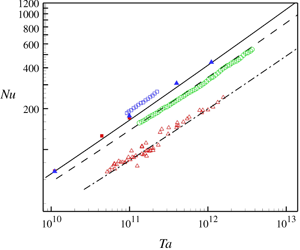Article contents
Large-eddy simulation and modelling of Taylor–Couette flow
Published online by Cambridge University Press: 12 March 2020
Abstract

Wall-resolved large-eddy simulations (LES) of the incompressible Navier–Stokes equations together with empirical modelling for turbulent Taylor–Couette (TC) flow are presented. LES were performed with the inner cylinder rotating at angular velocity  $\unicode[STIX]{x1D6FA}_{i}$ and the outer cylinder stationary. With
$\unicode[STIX]{x1D6FA}_{i}$ and the outer cylinder stationary. With  $R_{i},R_{o}$ the inner and outer radii respectively, the radius ratio is
$R_{i},R_{o}$ the inner and outer radii respectively, the radius ratio is  $\unicode[STIX]{x1D702}=0.909$. The subgrid-scale stresses are represented using the stretched-vortex subgrid-scale model while the flow is resolved close to the wall. LES is implemented in the range
$\unicode[STIX]{x1D702}=0.909$. The subgrid-scale stresses are represented using the stretched-vortex subgrid-scale model while the flow is resolved close to the wall. LES is implemented in the range  $Re_{i}=10^{5}{-}10^{6}$ where
$Re_{i}=10^{5}{-}10^{6}$ where  $Re_{i}=\unicode[STIX]{x1D6FA}_{i}R_{i}d/\unicode[STIX]{x1D708}$ and
$Re_{i}=\unicode[STIX]{x1D6FA}_{i}R_{i}d/\unicode[STIX]{x1D708}$ and  $d=R_{o}-R_{i}$ is the cylinder gap. It is shown that the LES can capture the salient features of the flow, including the quantitative behaviour of spanwise Taylor rolls, the log variation in the inner-cylinder mean-velocity profile and the angular momentum redistribution due to the presence of Taylor rolls. A simple empirical model is developed for the turbulent, TC flow for both a stationary outer cylinder and also for co-rotating cylinders. This consists of near-wall, log-like turbulent wall layers separated by an annulus of constant angular momentum. Model results include the Nusselt number
$d=R_{o}-R_{i}$ is the cylinder gap. It is shown that the LES can capture the salient features of the flow, including the quantitative behaviour of spanwise Taylor rolls, the log variation in the inner-cylinder mean-velocity profile and the angular momentum redistribution due to the presence of Taylor rolls. A simple empirical model is developed for the turbulent, TC flow for both a stationary outer cylinder and also for co-rotating cylinders. This consists of near-wall, log-like turbulent wall layers separated by an annulus of constant angular momentum. Model results include the Nusselt number  $Nu$ (torque required to maintain the flow) and measures of the wall-layer thickness as functions of both the Taylor number
$Nu$ (torque required to maintain the flow) and measures of the wall-layer thickness as functions of both the Taylor number  $Ta$ and
$Ta$ and  $\unicode[STIX]{x1D702}$. These are compared with results from measurement, direct numerical simulation and the LES. A model extension to rough-wall turbulent flow is described. This shows an asymptotic, fully rough-wall state where the torque is independent of
$\unicode[STIX]{x1D702}$. These are compared with results from measurement, direct numerical simulation and the LES. A model extension to rough-wall turbulent flow is described. This shows an asymptotic, fully rough-wall state where the torque is independent of  $Re_{i}/Ta$, and where
$Re_{i}/Ta$, and where  $Nu\sim Ta^{1/2}$.
$Nu\sim Ta^{1/2}$.
JFM classification
- Type
- JFM Papers
- Information
- Copyright
- © The Author(s), 2020. Published by Cambridge University Press
References
- 15
- Cited by


